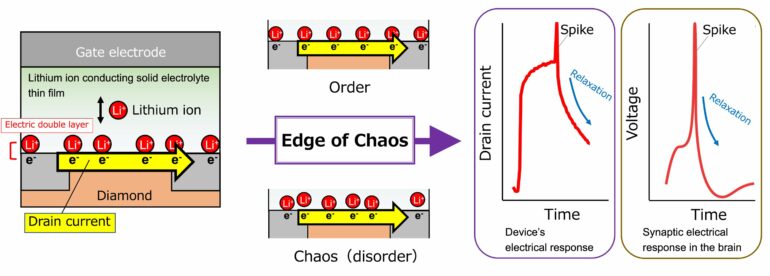A Tokyo University of Science research team has developed an AI device with high information processing performance. This was achieved by recreating the so-called “edge-of-chaos” state occurring in the brain using ion–electron-coupled dynamics at the solid electrolyte/diamond interface. This technology may be used to develop energy-efficient edge AI devices with a wide range of applications, including pattern recognition in images (including facial recognition), voices and odors.
The human brain is far more energy efficient than the computers used in current AI technologies and superior in information processing performance. One possible reason for this is that the “edge-of-chaos” state taking place in the brain has not been incorporated into computers.
Attempts have been made to develop hardware capable of recreating the edge-of-chaos state by fabricating large-scale integrated circuits consisting of numerous miniaturized devices. However, actually developing these circuits has proven challenging and their performance has only been estimated through simulations.
This research team recently developed an AI device with high information processing performance by reproducing the brain’s edge-of-chaos state using ion–electron-coupled dynamics at the lithium ion conducting solid electrolyte thin film/diamond thin film interface. This device operates in the same manner as an electric double layer transistor in that its electrical resistance changes with the changing charge/discharge states of the electric double layer.
The device is able to induce an edge-of-chaos state, enabling it to produce electrical responses with spike and relaxation patterns similar to those of synaptic responses in the brain and efficiently process information. As a result, this AI device was able to convert waveform input signals into signals in a different, intended waveform six times more accurately than other similar small AI devices, achieving the world’s highest performance at this task.
This research demonstrated that brain-like information processing can be achieved by recreating the brain’s edge-of-chaos state in an electric double layer a few nanometers in thickness at the solid electrolyte thin film/diamond thin film interface.
This new nanoscale technology may potentially be applicable in the development of practical, high-performance, small AI devices. These could include energy-efficient edge AI devices that could be combined with various sensors to create smart watches, surveillance cameras, voice recognition systems and other technologies with a wide range of applications (e.g., medicine, disaster preparation, manufacturing and security).
This research was published in the December 14, 2022, issue of Science Advances.
More information:
Daiki Nishioka et al, Edge-of-chaos learning achieved by ion-electron–coupled dynamics in an ion-gating reservoir, Science Advances (2022). DOI: 10.1126/sciadv.ade1156
Provided by
National Institute for Materials Science
Citation:
Development of an ionic device capable of brain-like information processing (2023, January 12)



